北外语言学概论2006(6-10)..
北外专业目录及参考书目

2011北京外国语大学中国语言文学学院语言学及应用语言学考研招生目录参考书目初试复试科目050102语言学及应用语言学2009 招生目录(本专业招生 20 人)研究方向(55)对外汉语教学理论(012中国语言文学学院)(56)汉语研究(012中国语言文学学院)(57)汉外语言对比(012中国语言文学学院)初试科目(55)对外汉语教学理论(012中国语言文学学院)考试内容:1、101政治2、201英、202俄、203日、212法、213德选一3、711 语言综合卷(古、现代汉语、语言学概论)4、923对外汉语教学理论(56)汉语研究(012中国语言文学学院)考试内容:1、101政治2、201英语3、711 语言综合卷(古、现代汉语、语言学概论)4、924现代汉语(57)汉外语言对比(012中国语言文学学院)考试内容:1、101政治2、201英语3、711 语言综合卷(古、现代汉语、语言学概论)4、925对比语言学参考书目1、现代汉语《现代汉语》,黄伯荣、廖序东著,高等教育出版社。
《语法讲义》,朱德熙著,商务印书馆。
古代汉语《古代汉语》,王力主编,中华书局。
2、语言学概论《语言学概论》,高名凯、石安石著,中华书局。
《语言学纲要》,叶蜚声、徐通锵著,北京大学出版社。
3、对外汉语教学《对外汉语教学入门》,周小兵、李海鸥主编,中山大学出版社。
《对外汉语教育学引论》,刘珣著,北京语言文化大学出版社。
《对外汉语教学理论研究》,李泉主编,商务印书馆。
4、汉日语言对比《汉日语言对比研究》,张麟声著,北京大学出版社。
《概说现代日语语法》,铃木康之主编,彭广陆编译,吉林教育出版社。
复试备注(55)含自筹6名(56)含自筹3名(57)本届只招汉日对比含自筹1名050102语言学及应用语言学2008 招生目录(本专业招生 31 人)研究方向(50)对外汉语教学理论(51)国际汉语教育(52)汉语研究(53)汉日语言对比初试科目①101政治②201英、202俄、203日、212法、213德选一③712 语言综合卷(古、现代汉语、语言学概论)④911对外汉语教学理论考试科目①101政治②201英、202俄、203日、212法、213德选一③712 语言综合卷(古、现代汉语、语言学概论)④912现代汉语①101政治②201英语③712语言综合卷(古、现代汉语、语言学概论)④912现代汉语①101政治②201英语③712语言综合卷(古、现代汉语、语言学概论)④913对比语言学参考书目语言学及应用语言学(50)—(53)对外汉语教学理论国际汉语教育汉语研究汉日语文对比1、现代汉语《现代汉语》,黄伯荣、廖序东著,高等教育出版社。
北外考研参考书目

部分研究方向参考书目研究方向、第二外语参考书目(01)英语语言学与应用语言学1、G.Yule (1996) The Study of Language 2nd.ed. CUP2、V.Cook (1996) Second Language Learning and Language Teaching 2nd.ed. Arnold3、丁声树等,(1961)《现代汉语语法讲话》商务印书馆出版(02)英美文学1、M.H.Abrams 编《诺顿英国文学选集》W.W. Norton 20022、Nina Baym 编《诺顿美国文学选集》W.W. Norton 20053、金莉、张剑编《文学原理教程》外研社20054、Raman Selden《当代文学理论导读》外研社20045、赵一凡等编《西方文论关键词》外研社2004(03)美国社会文化研究1、Thomas A. Bailey, David M Kennedy & Lizabeth Cohen. The American Pageant-A History of the Republic, 11th edition, Houghton Mifflin Company 1998, 北外研招办2、梅仁毅主编:《美国研究读本》外研社2002(04)英国社会文化研究1、肖慧云主编《当代英国概况》上海外语教育出版社出版20032、余志远主编《英语国家概况》外研社19963、朱永涛王立礼主编《英语国家社会与文化入门》高教社2005(05)澳大利亚研究1、《澳大利亚历史》1788-1942 北京出版社2、《澳大利亚历史》1942-1988 北京出版社3、夏玉和、李又文编《澳大利亚社会与文化》外研社20084. 朱永涛王立礼主编《英语国家社会与文化入门》高教社2005(06)爱尔兰研究1.梅仁毅主编:《英语国家社会与文化》(爱尔兰部分),北京:外研社2010 2.朱永涛、王立礼主编:《英语国家社会与文化入门》(爱尔兰部分),北京:高教社20003.陈恕主编:《爱尔兰文学名篇选注》,北京:外研社2010(特别是准备报考爱尔兰文学子方向的考生需通读此书)4.王振华、陈志瑞、李靖堃编:《列国志:爱尔兰》,北京:社会科学出版社2007 (07)国际新闻1、新华社中英文稿、《中国日报》、《纽约时报》、《时代》周刊2、国内公开出版的中国和外国新闻史书籍3、鲁曙明、洪浚浩:《传播学》,中国人民大学出版社2007(08)英美文论与文化研究1) Abrams, M. H. A Glossary of Literary Terms. Beijing: Foreign Language Teaching and Research P, 2004.2) Fowler, Alastair. A History of English Literature: Forms and Kinds from the Middle Ages to the Present. Oxford: Basil Blackwell, 1987.3) Columbia Literary History of the United States. New York: Columbia UP, 1988.4) Abrams, M.H. ed. The Norton Anthology of English Literature: The Major Authors. 5th ed. New York: Norton, 1987.5) Baym, Nina, ed. The Norton Anthology of American Literature. Shorter 5th ed. New York: Norton, 1999(09)英语翻译理论与实践1、Bassnett, Susan.《翻译研究》Translation Studies. 外教社.2004.2、Gentzler, Edwin.《当代翻译理论(第二版修订本)》Contemporary Translation Theories. 外教社20043、马会娟、苗菊编.《当代西方翻译理论选读》. 外研社. 2009(54)—(60)1、《中式英语之鉴》Joan Pinkham 、姜桂华著,2000年,外语教学与研究出版社。
北京外国语大学俄语语言文学—俄语语言学(俄语学院)考博招生介绍—考试内容—考试指南
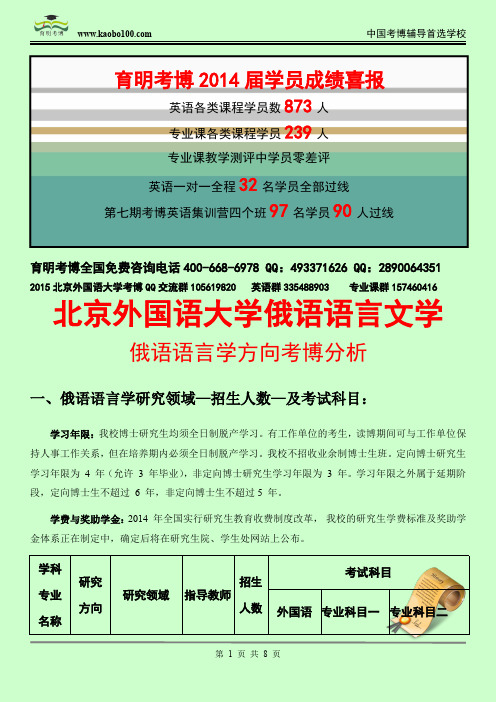
育明考博全国免费咨询电话400-668-6978QQ:493371626QQ:2890064351 2015北京外国语大学考博QQ交流群105619820英语群335488903专业课群157460416北京外国语大学俄语语言文学俄语语言学方向考博分析一、俄语语言学研究领域—招生人数—及考试科目:学习年限:我校博士研究生均须全日制脱产学习。
有工作单位的考生,读博期间可与工作单位保持人事工作关系,但在培养期内必须全日制脱产学习。
我校不招收业余制博士生班。
定向博士研究生学习年限为4年(允许3年毕业),非定向博士研究生学习年限为3年。
学习年限之外属于延期阶段,定向博士生不超过6年,非定向博士生不超过5年。
学费与奖助学金:2014年全国实行研究生教育收费制度改革,我校的研究生学费标准及奖助学金体系正在制定中,确定后将在研究生院、学生处网站上公布。
学科专业名称研究方向研究领域指导教师招生人数考试科目外国语专业科目一专业科目二育明考博2014届学员成绩喜报英语各类课程学员数873人专业课各类课程学员239人专业课教学测评中学员零差评英语一对一全程32名学员全部过线第七期考博英语集训营四个班97名学员90人过线050202俄语语言文学(002俄语学院)俄语语言学语篇语言学史铁强1-2二外英语俄语语言学基础语篇语言学语用语言学武瑗华1-2语用语言学二、导师介绍:史铁强:1954年11月生于辽宁省沈阳市。
1977年考入辽宁师范学院外语系,1981年本科毕业。
同年考入四川外语学院俄语系攻读硕士学位研究生,1984年毕业并获得硕士学位。
毕业后分配到中国人民警官大学外语系工作,不久任俄语教研室副主任。
1987年考入北京外国语学院攻读博士学位研究生,1990年毕业并同时获得博士学位。
毕业后留校任教至今。
其间两次到俄罗斯进修,并于2002-2003年在中国驻俄罗斯大使馆教育处任一等秘书。
现任:北京外国语大学俄语学院院长,教授,博士生导师;教育部外语教学指导委员会委员兼俄语四、八级测试组组长;中国俄语教学研究会副会长;国务院学位委员会外文学科组秘书;《中国俄语教学》编辑部成员。
北京外国语大学(已有10试题)
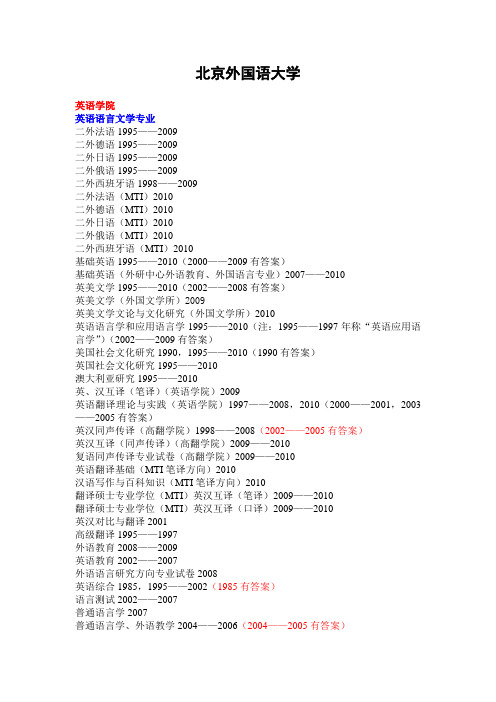
北京外国语大学英语学院英语语言文学专业二外法语1995——2009二外德语1995——2009二外日语1995——2009二外俄语1995——2009二外西班牙语1998——2009二外法语(MTI)2010二外德语(MTI)2010二外日语(MTI)2010二外俄语(MTI)2010二外西班牙语(MTI)2010基础英语1995——2010(2000——2009有答案)基础英语(外研中心外语教育、外国语言专业)2007——2010英美文学1995——2010(2002——2008有答案)英美文学(外国文学所)2009英美文学文论与文化研究(外国文学所)2010英语语言学和应用语言学1995——2010(注:1995——1997年称“英语应用语言学”)(2002——2009有答案)美国社会文化研究1990,1995——2010(1990有答案)英国社会文化研究1995——2010澳大利亚研究1995——2010英、汉互译(笔译)(英语学院)2009英语翻译理论与实践(英语学院)1997——2008,2010(2000——2001,2003——2005有答案)英汉同声传译(高翻学院)1998——2008(2002——2005有答案)英汉互译(同声传译)(高翻学院)2009——2010复语同声传译专业试卷(高翻学院)2009——2010英语翻译基础(MTI笔译方向)2010汉语写作与百科知识(MTI笔译方向)2010翻译硕士专业学位(MTI)英汉互译(笔译)2009——2010翻译硕士专业学位(MTI)英汉互译(口译)2009——2010英汉对比与翻译2001高级翻译1995——1997外语教育2008——2009英语教育2002——2007外语语言研究方向专业试卷2008英语综合1985,1995——2002(1985有答案)语言测试2002——2007普通语言学2007普通语言学、外语教学2004——2006(2004——2005有答案)普通语言学及应用语言学(外研中心)2010句法、第二语言习得2003综合考试(含国际政治、汉语)2000——2002英语新闻业务与新闻学基础知识2006——2009国际新闻2010国际法学专业(无此试卷)外交学专业综合考试(含国际政治、汉语)2000——2002中国外语教育研究中心外国语语言学及应用语言学专业二外法语1995——2009二外德语1995——2009二外日语1995——2009二外俄语1995——2009二外西班牙语1998——2009二外法语(MTI)2010二外德语(MTI)2010二外日语(MTI)2010二外俄语(MTI)2010二外西班牙语(MTI)2010基础英语1995——2010(2000——2009有答案)基础英语(外研中心外语教育、外国语言专业)2007——2010英美文学1995——2010(2002——2008有答案)英美文学(外国文学所)2009英美文学文论与文化研究(外国文学所)2010英语语言学和应用语言学1995——2010(注:1995——1997年称“英语应用语言学”)(2002——2009有答案)美国社会文化研究1990,1995——2010(1990有答案)英国社会文化研究1995——2010澳大利亚研究1995——2010英、汉互译(笔译)(英语学院)2009英语翻译理论与实践(英语学院)1997——2008,2010(2000——2001,2003——2005有答案)英汉同声传译(高翻学院)1998——2008(2002——2005有答案)英汉互译(同声传译)(高翻学院)2009——2010复语同声传译专业试卷(高翻学院)2009——2010英语翻译基础(MTI笔译方向)2010汉语写作与百科知识(MTI笔译方向)2010翻译硕士专业学位(MTI)英汉互译(笔译)2009——2010翻译硕士专业学位(MTI)英汉互译(口译)2009——2010英汉对比与翻译2001高级翻译1995——1997外语教育2008——2009英语教育2002——2007外语语言研究方向专业试卷2008英语综合1985,1995——2002(1985有答案)文化语言学2007语言测试2002——2007普通语言学2007普通语言学、外语教学2004——2006(2004——2005有答案)普通语言学及应用语言学(外研中心)2010句法、第二语言习得2003综合考试(含国际政治、汉语)2000——2002外国文学所英语语言文学专业二外法语1995——2009二外德语1995——2009二外日语1995——2009二外俄语1995——2009二外西班牙语1998——2009二外法语(MTI)2010二外德语(MTI)2010二外日语(MTI)2010二外俄语(MTI)2010二外西班牙语(MTI)2010基础英语1995——2010(2000——2009有答案)基础英语(外研中心外语教育、外国语言专业)2007——2010英美文学1995——2010(2002——2008有答案)英美文学(外国文学所)2009英美文学文论与文化研究(外国文学所)2010英语语言学和应用语言学1995——2010(注:1995——1997年称“英语应用语言学”)(2002——2009有答案)美国社会文化研究1990,1995——2010(1990有答案)英国社会文化研究1995——2010澳大利亚研究1995——2010英、汉互译(笔译)(英语学院)2009英语翻译理论与实践(英语学院)1997——2008,2010(2000——2001,2003——2005有答案)英汉同声传译(高翻学院)1998——2008(2002——2005有答案)英汉互译(同声传译)(高翻学院)2009——2010复语同声传译专业试卷(高翻学院)2009——2010英语翻译基础(MTI笔译方向)2010汉语写作与百科知识(MTI笔译方向)2010翻译硕士专业学位(MTI)英汉互译(笔译)2009——2010翻译硕士专业学位(MTI)英汉互译(口译)2009——2010英汉对比与翻译2001高级翻译1995——1997外语教育2008——2009英语教育2002——2007外语语言研究方向专业试卷2008英语综合1985,1995——2002(1985有答案)语言测试2002——2007普通语言学2007普通语言学、外语教学2004——2006(2004——2005有答案)普通语言学及应用语言学(外研中心)2010句法、第二语言习得2003综合考试(含国际政治、汉语)2000——2002德语语言文学专业二外英语1997——2003(2000——2003有答案)德国外交经济2000——2005德国文学2001——2005德语翻译理论与实践2000——2005基础德语2000——2005德语教学法2004——2005德语跨文化经济交际2000——2005德语语言学2000——2005国际问题研究所外交学专业综合考试(含国际政治、汉语)2000——2002社会科学部外交学专业综合考试(含国际政治、汉语)2000——2002国际商学院外交学专业综合考试(含国际政治、汉语)2000——2002俄语学院俄语语言文学专业二外英语1997——2003(2000——2003有答案)俄罗斯社会与文化2002——2003,2005俄罗斯文学2002——2005俄语翻译2004俄语翻译技巧2002翻译理论(俄语专业)2003俄语翻译理论与实践2005俄语基础2004——2005俄语语言学基础理论2002——2004现代俄语语言学2005俄语综合2002法语系法语语言文学专业二外英语1997——2003(2000——2003有答案)欧洲语言学专业二外英语1997——2003(2000——2003有答案)德语系德语语言文学专业二外英语1997——2003(2000——2003有答案)德国外交经济2000——2005德国文学2001——2005德语翻译理论与实践2000——2005基础德语2000——2005德语教学法2004——2005德语跨文化经济交际2000——2005德语语言学2000——2005日语系日语语言文学专业二外英语1997——2003(2000——2003有答案)日本社会文化2004(日语系)日本语言文学2004(日语系)以下试卷为日研中心试卷,仅供参考:专业日语2009(2009有答案)基础日语1997——2006,2008——2009(2000——2006,2008——2009有答案)日本概况2003——2005(2003——2005有答案)日本社会1997——2004(2000——2004有答案)日本社会经济2008(2008有答案)日本社会日本经济2005——2006(2005——2006有答案)日本文化1997——2004,2008(2000——2004,2008有答案)日本文学1997——2004,2008(2000——2004,2008有答案)日本文学日本文化2005——2006(2005——2006有答案)日本语言1997——2004(2000——2004有答案)日本语教育2008(2008答案)日本语言日本教育2005——2006(2005——2006有答案)日本语学2008(2008有答案)综合考试(日语专业)1997——2002(2000——2002有答案)日研中心日语语言文学专业二外英语1997——2003(2000——2003有答案)专业日语2009(2009有答案)基础日语1997——2006,2008——2009(2000——2006,2008——2009有答案)日本概况2003——2005(2003——2005有答案)日本社会1997——2004(2000——2004有答案)日本社会经济2008(2008有答案)日本社会日本经济2005——2006(2005——2006有答案)日本文化1997——2004,2008(2000——2004,2008有答案)日本文学1997——2004,2008(2000——2004,2008有答案)日本文学日本文化2005——2006(2005——2006有答案)日本语言1997——2004(2000——2004有答案)日本语教育2008(2008答案)日本语言日本教育2005——2006(2005——2006有答案)日本语学2008(2008有答案)综合考试(日语专业)1997——2002(2000——2002有答案)西葡系西班牙语语言文学专业二外英语1997——2003(2000——2003有答案)西班牙语基础2003——2004(其中2004年的试卷共12页,缺P11-12)西班牙语专业2003——2004欧洲语言学专业二外英语1997——2003(2000——2003有答案)阿语系阿拉伯语语言文学专业二外英语1997——2003(2000——2003有答案)欧洲语系欧洲语言文学专业二外英语1997——2003(2000——2003有答案)亚非语系亚非语言文学专业(无此试卷)国际交流学院语言学及应用语言学专业比较文学概论2004海外汉学2003——2004现代汉语1999古代汉语1999综合考试(含国际政治、汉语)2000——2002综合考试(含古代汉语、古代文学、现当代文学)2001中国历史文化2001历史文化综合1999——2000语言学与应用语言学专业综合2000语言学及现代汉语2000——2001比较文学与世界文学专业比较文学概论2004海外汉学2003——2004中国古代文学专业综合考试(含古代汉语、古代文学、现当代文学)2001高翻学院外国语语言学及应用语言学专业二外法语1995——2009二外德语1995——2009二外日语1995——2009二外俄语1995——2009二外西班牙语1998——2009二外法语(MTI)2010二外德语(MTI)2010二外日语(MTI)2010二外俄语(MTI)2010二外西班牙语(MTI)2010基础英语1995——2010(2000——2009有答案)基础英语(外研中心外语教育、外国语言专业)2007——2010英汉互译(同声传译)(高翻学院)2009——2010英汉同声传译(高翻学院)1998——2008(2002——2005有答案)英、汉互译(笔译)(英语学院)2009英语翻译理论与实践(英语学院)1997——2008,2010(2000——2001,2003——2005有答案)复语同声传译专业试卷(高翻学院)2009——2010英语翻译基础(MTI笔译方向)2010汉语写作与百科知识(MTI笔译方向)2010翻译硕士专业学位(MTI)英汉互译(笔译)2009——2010翻译硕士专业学位(MTI)英汉互译(口译)2009——2010英汉对比与翻译2001高级翻译1995——1997外语教育2008——2009英语教育2002——2007外语语言研究方向专业试卷2008英语综合1985,1995——2002(1985有答案)语言测试2002——2007普通语言学2007普通语言学、外语教学2004——2006(2004——2005有答案)普通语言学及应用语言学(外研中心)2010句法、第二语言习得2003综合考试(含国际政治、汉语)2000——2002英语语言学和应用语言学1995——2010(注:1995——1997年称“英语应用语言学”)(2002——2009有答案)。
北外二外德语06~09真题答案
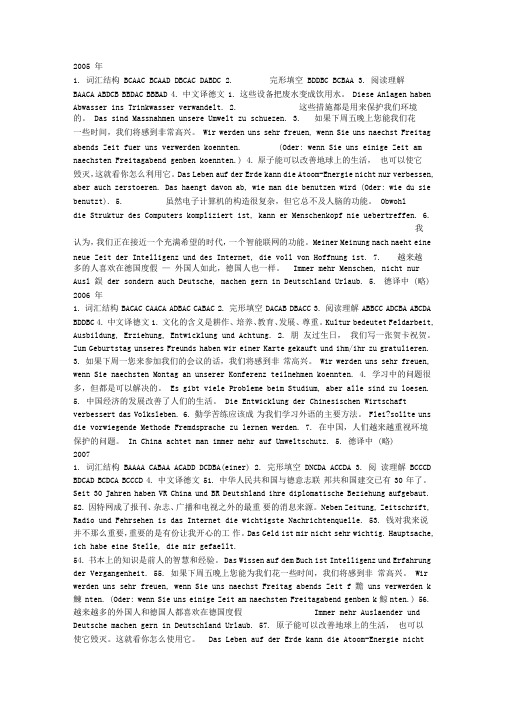
2005 年1. 词汇结构 BCAAC BCAAD DBCAC DABDC2. 完形填空 BDDBC BCBAA3. 阅读理解BAACA ABDCB BBDAC BBBAD 4. 中文译德文 1. 这些设备把废水变成饮用水。
Diese Anlagen haben Abwasser ins Trinkwasser verwandelt. 2. 这些措施都是用来保护我们环境的。
Das sind Massnahmen unsere Umwelt zu schuezen. 3. 如果下周五晚上您能我们花一些时间,我们将感到非常高兴。
Wir werden uns sehr freuen, wenn Sie uns naechst Freitag abends Zeit fuer uns verwerden koennten. (Oder: wenn Sie uns einige Zeit am naechsten Freitagabend genben koennten.) 4. 原子能可以改善地球上的生活,也可以使它毁灭,这就看你怎么利用它。
Das Leben auf der Erde kann die Atoom-Energie nicht nur verbessen, aber auch zerstoeren. Das haengt davon ab, wie man die benutzen wird (Oder: wie du sie benutzt). 5. 虽然电子计算机的构造很复杂,但它总不及人脑的功能。
Obwohldie Struktur des Computers kompliziert ist, kann er Menschenkopf nie uebertreffen. 6.我认为,我们正在接近一个充满希望的时代,一个智能联网的功能。
Meiner Meinung nach naeht eine neue Zeit der Intelligenz und des Internet, die voll von Hoffnung ist. 7. 越来越多的人喜欢在德国度假—外国人如此,德国人也一样。
北师大语言学及应用语言学考研真题

语言学概论2001一、术语解释题(10分)语音同化粘着语语言习得语言能力语法范畴二,填空题(10分)1.我们把语音分为口音/鼻音的对立,送气/不送气的对立,塞音/擦音的对立等,这是根据语音中的——分的类。
2.在语言类型学中,日语、朝鲜语、维吾尔语属于——型语言。
3.当今形式主义语法学派中最有影响的理论是——,系统功能语法学派的代表人物是——。
4.非亲属语言因同化而发生融合,形成一种混合语言,并被该社会采用为主要交际工具,作为母语来学习和使用,这种语言叫做——。
5.当今世界上文字主要有——文字、——文字、——文字三种类型。
6.对人脑的机制以及人脑与语言之间的关系进行研究的语言学叫做——。
7.景颇语以至于汉藏语系的——语支。
二,分析题(30分)1.请给下面一句话用国际音标注音,并分析其中的音位变体。
(6分)一个在枯黄田野上劳碌半世的人,终于等来草木青青的一年。
2.按照你的理解,请从语素角度分析下列结构。
(说明各由几个语素组成,是自由语素还是粘着语素)(6分)(1)歌星--歌迷--歌唱家---歌手--民歌(2)酒吧--网吧--陶吧--书吧(3)卡拉OK--OK(4) 葡萄--葡萄干--葡萄园--葡萄酒--提子3.分析下列加点词语中的色彩意义。
(6分)(1)“癞皮狗,你骂谁?”王胡轻蔑地抬起眼来说。
(2)她的晚年,据我想,是总算不很辛苦的,享寿也不小了,正无须我来下泪。
况且哭的人不是多着么,连先前竭力欺凌她的人们也哭,至少脸上很惨然。
(鲁迅《孤独者》)(3)“不怕,不怕,我老孙头怕啥?我是有啥说啥的,要说韩老六这人吧,也大不离。
你瞅那旁拉的苞米”。
老孙头用别的话岔开关于韩老六的文化:“这叫老母猪不翘脚,都是胡子闹瞎的,今年会缺吃的呀,同志。
”4.分析下列各组中A句和B句的语义关系,指出预设(前提)句或蕴涵句。
(6分)(1)A.这次开会没人缺席。
B.这次开会小王没缺席(2)A.北京的天安门广场有人民英雄纪念碑。
北京外国语大学俄语学院俄语语言学考博考博参考书目导师笔记重点(精)
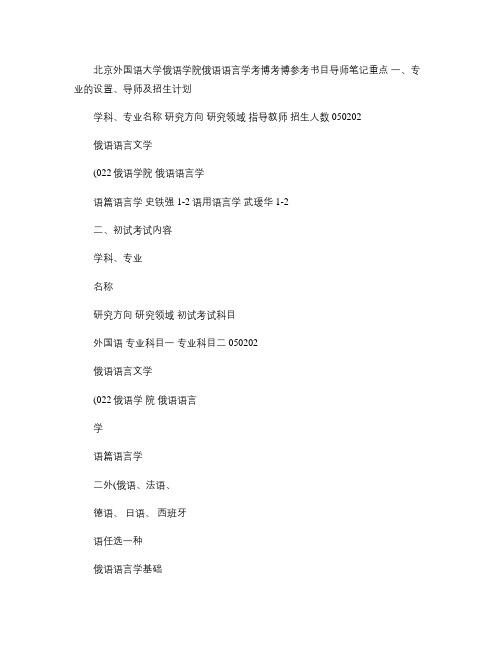
北京外国语大学俄语学院俄语语言学考博考博参考书目导师笔记重点一、专业的设置、导师及招生计划学科、专业名称研究方向研究领域指导教师招生人数 050202俄语语言文学(022俄语学院俄语语言学语篇语言学史铁强 1-2语用语言学武瑗华 1-2二、初试考试内容学科、专业名称研究方向研究领域初试考试科目外国语专业科目一专业科目二 050202俄语语言文学(022俄语学院俄语语言学语篇语言学二外(俄语、法语、德语、日语、西班牙语任选一种俄语语言学基础语篇语言学语用语言学语用语言学三、参考书目研究方向参考书目俄语语篇语言学 (俄语学院史铁强教授 1、ГальперинИ.Р.Тексткакобъектлингвистическогоисследования.М.,1981.2、ШевченкоН.В.Основылингвистикитекста:Учебноепособие.М.,2003.3、胡壮麟:《语篇的衔接与连贯》 ,上海:上海外语教育出版社, 1994年。
4、王福祥:《话语语言学概论》 ,北京:外语教学与研究出版社, 1994年。
5、史铁强等:《语篇语言学概论》 ,北京:外语教学与研究出版社, 2012。
俄语语用语言学 1、Русскаяграмматика.т.I, т.II.АкадемиянаукСССР.М.,1980.2、张家骅:《语法·语义·语用——现代俄语研究》 ,哈尔滨:黑龙江人民出版(俄语学院武瑗华教授社, 2000年。
3、何自然:《语用学概论》 ,长沙:湖南教育出版社, 1988年。
4、何兆熊:《语用学概要》 ,上海:上海外语教育出版社, 1989年。
5、索振羽:《语用学教程》 ,北京:北京大学出版社, 2000年。
四、关于北京外国语学院考博注意事项(一报考类别,包括以下两种类型:①非定向:录取后没有保持人事关系的正式工作单位,读博期间个人人事档案及户口转入学校 (户口是否转入自愿,毕业后在国家政策指导下自主择业。
北京语言大学语言学及应用语言学参考书目

北京语言大学语言学及应用语言学参考书目1 概论高明凯、石安石主编《语言学概论》,北京,中华书局,1979刘伶、黄智显、陈秀珠主编《语言学概论》,北京,北京师范大学出版社,1984吴为章编著《新编普通语言学教程》,北京,北京广播学院出版社,1999 [较深]伍铁平主编《普通语言学概要》,北京,高等教育出版社,1993兹维金采夫《普通语言学纲要》(1962),伍铁平、马福聚、汤庭国等译,北京,商务印书馆,19812 语言学理论索绪尔《普通语言学教程》(1916),高明凯等译,岑麒祥、叶蜚声校,北京,商务印书馆,1982 [初读有一定难度,但需要仔细品味]赵元任《语言问题》,北京,商务印书馆,1980Lyons,J.Linguistics,1980,载南开大学中文系《语言研究译丛》编辑部编:《语言研究译丛》第二期,天津,天津人民出版社,1988于根元主编《应用语言学概论》,北京,商务印书馆,2003宋国明《句法理论概要》,北京,中国社会科学出版社,1997Radford,A.1997.Syntax:A Minimalist Introduction.Cambridge:Cambridge University Press张敏《认知语言学与汉语名词短语》,北京,中国社会科学出版社,1998徐通锵《历史语言学》,北京,商务印书馆,1991 [较深]陈原《社会语言学》,北京,学林出版社,1983斯大林《马克思主义和语言学问题》,中共中央马恩列斯著作编译局译,北京,人民出版社,1971卫志强《当代跨学科的语言学》,北京,北京语言学院出版社(现在叫北京语言大学出版社了),1992语言在交际中规范施春宏中国经济出版社西方语言学流派刘润清外语教学与研究出版社语言理解与认知崔希亮北京语言文化大学出版社3 语言学史岑麒祥《语言学史概要》,北京,北京大学出版社,1988R.H.罗宾斯《简明语言学史》,许德宝、冯建明、胡明亮译,北京,中国社会科学出版社,19874 本体研究(一般参考现代汉语课老师开的参考文献)罗常培、王均《普通语言学纲要(修订本)》,北京,商务印书馆,2002陆俭明《现代汉语语法研究教程》,北京,北京大学出版社,2003朱德熙《语法答问》,北京,商务印书馆,1985蒋绍愚《近代汉语研究概况》,北京,北京大学出版社,1994 [较深]5 其他岑麒祥《普通语言学人物志》,北京大学出版社,1989罗常培《语言与文化》,语文出版社,1989王希杰主编《语言学百题(修订本)》,上海教育出版社,1991王振昆、谢文庆、刘振铎编《语言学资料选编》,中央广播电视大学出版社,1983《现代汉语》参考文献目录l 第一章绪论胡裕树《现代汉语》(增订二版)绪论部分,上海教育出版社。
北京外国语大学英语学院导师介绍:窦薇、陈亚平
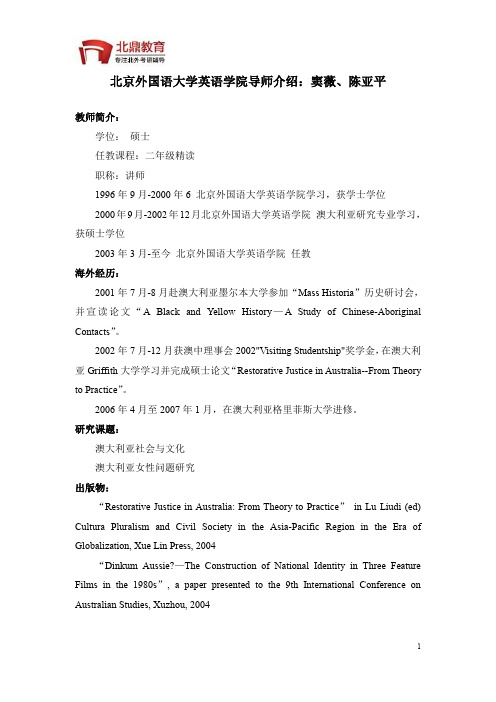
北外建校 60 周年学术论文集 2001 ” 外语教学与研究出版社 2005 “注重语言形式与二语习得”外语教学与研究出版社 2005
(文章来源:考研网)
3
2006 年 4 月至 2007 年 1 月,在澳大利亚格里菲斯大学进修。 研究课题:
澳大利亚社会与文化 澳大利亚女性问题研究 出版物: “Restorative Justice in Australia: From Theory to Practice” in Lu Liudi (ed) Cultura Pluralism and Civil Society in the Asia-Pacific Region in the Era of Globalization, Xue Lin Press, 2004 “Dinkum Aussie?—The Construction of National Identity in Three Feature Films in the 1980s”, a paper presented to the 9th International Conference on Australian Studies, Xuzhou, 2004
海外经历: 2001 年 7 月-8 月赴澳大利亚墨尔本大学参加“Mass Historia”历史研讨会,
并 宣 读 论 文 “ A Black and Yellow History — A Study of Chinese-Aboriginal Contacts”。
2002 年 7 月-12 月获澳中理事会 2002"Visiting Studentship"奖学金,在澳大利 亚 Griffith 大学学习并完成硕士论文“Restorative Justice in Australia--From Theory to Practice”。
北京外国语大学中国外语教育研究中心外国语言学及应用语言学历年考研真题及详解专业课考试试题
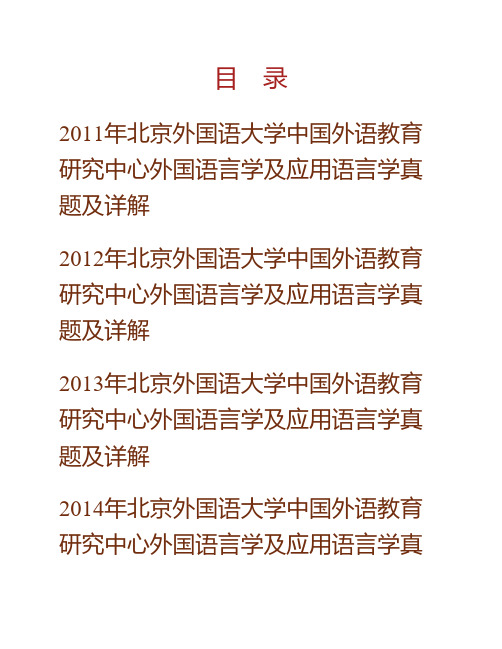
目 录2011年北京外国语大学中国外语教育研究中心外国语言学及应用语言学真题及详解2012年北京外国语大学中国外语教育研究中心外国语言学及应用语言学真题及详解2013年北京外国语大学中国外语教育研究中心外国语言学及应用语言学真题及详解2014年北京外国语大学中国外语教育研究中心外国语言学及应用语言学真题及详解2015年北京外国语大学中国外语教育研究中心外国语言学及应用语言学真题及详解2011年北京外国语大学中国外语教育研究中心外国语言学及应用语言学真题及详解I. Briefly explain the following terms. (20 points)1.perlocutionary act【答案】According to Austin, a speaker might be performing three acts simultaneously when speaking: locutionary act illocutionary act perlocutionary act. A perlocutionary act is the effect of the utterance. Thus, by saying “Morning!” the speaker has made it clear that he wants to keep friendly relations with the hearer.2.minimal pair【答案】Minimal pairs are the two words which are identical in every way except for one sound segment that occurs in the same place in the string. For example, the English words bear and pear constitute a minimal pair as they differ in meaning and in their initial phonemes /b/ and /p/.3.distinctive feature【答案】The distinctive feature refers to a property which distinguishes one phoneme from another. For example, “voicing” is a distinctive feature, since it plays an important role in distinguishing obstruents in English.4.linguistic variable【答案】Linguistic variable are those where the meaning remain constant but form varies like cat and pussy have the same social meaning but different form. So far pronunciation is concerned house [h] and with [h] has same social meaning with different pronunciation. Here variables are just the tools to analyze the language to set social dimensional society.5.lingua franca【答案】It is a language that is used for communication between different groups of people, each speaking a different language. The lingua franca couldbe an internationally used language of communication (e. g. English), it could be the native language of one of the groups, or it could be a language which is not spoken natively by any of the groups but has a simplified sentence structure and vocabulary and is often a mixture of two or more languages.II. Answer the following questions. (30 points)1.Why do we say linguistics is a science? (10 points)【答案】Linguistics is generally defined as the scientific study of language. It tries to answer the basic questions “What is language?” and “How does language work?” Linguistics studies not any particular language, e.g. English, Chinese, Arabic, and Latin, but it studies languages in general.It is a scientific study because it is based on the systematic investigation of linguistic data, conducted with reference to some general theory of language structure. In order to discover the nature and rules of the underlying language system, what the linguist has to do first is to collect and observe language facts, which arc found to display some similarities, and generalizations are made about them; then he formulates some hypotheses about the language structure. But the hypotheses thus formed have to be checked repeatedly against the observed facts to fully prove their validity. In linguistics, as in any other discipline, data and theory stand in a dialectical complementation; that is, a theory without the support of data can hardly claim validity, and data without being explained by some theory remain a muddled mass of things.(此题考查语言学作为一门学科其科学性,此题开放性试题,从其研究内容及方法角度作答即可。
《语言学概论》综合练习题及参考答案.doc

《语言学概论》综合练习题及参考答案一、判断(一)1.我国古代的书面语叫文言文。
(X)2.埃及是世界上有名的文明古国,是语言学的三大发源地之一。
(X)3.索绪尔被人们称之为现代语言学之父,其代表著作为《普通语言学教程》。
(V)4.语言单位的组合具有一定的规则,例如汉语动词后面的宾语一般是名词充当,所以只要在动词后面放一个名词就能组成述宾结构。
(X)5.语言和文字都是人类最重要的交际工具。
(X)6.语言作为社会现象,不是属于上层建筑,而是属于经济基础。
(X)7.语言和思维是不同性质的东西,二者没有任何联系。
(X)8.在一定的条件下,身势等伴随动作也可以脱离语言而独立完成一些交际任务。
(V )9.现代社会沟通的方式很多,语言的重要性正日渐削弱。
(X)10.我们常听人们说“工人有工人的语言,农民有农民的语言”,这说明语言是有阶级性的。
(X)11.语言是组成社会的一个不可缺少的因素,没有语言可以说就没有人类社会的存在。
(")12.语言是思维的工具,没有语言,人类就无法进行有效的思维。
(J)13.会不会说话是人类和动物的根本区别之一。
(J)14.语言和思维是两种独立的现象,但它们又形影相随,不可分离。
(J)15.任何一种符号都包括内容和意义两个方面,二者缺一不可。
(X)16.人的语言能力是天生的,是先天具备的。
(J)17.语言符号具有任意性的特点,因此我们可以自由地使用语音形式表达意义,例如把shuiguo (水果)说成guoshui o ( X )18.人们般认为人类有5000多种语言。
人类之所以有这么多种语言,究其根本原因是由于语言的音义结合具有任意性特点而造成的。
(/)19.语言符号的二层性特点是指语言是由语音和词汇组成的。
(X)20.儿童在中国长大就会说汉语,在英国长大则会说英语,这说明人类具有学习语言的本能。
(X)(二)1.组合规则是客观存在的,大家必须共同遵守。
V2.聚合规则是潜在的,意思是聚合规则并不存在。
北语考研十年初试真题(语言学概论)
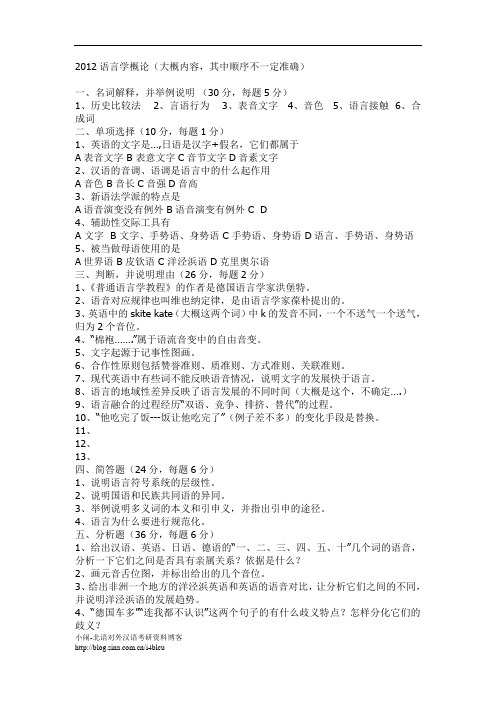
2012语言学概论(大概内容,其中顺序不一定准确)一、名词解释,并举例说明(30分,每题5分)1、历史比较法2、言语行为3、表音文字4、音色5、语言接触6、合成词二、单项选择(10分,每题1分)1、英语的文字是…,日语是汉字+假名,它们都属于A表音文字 B 表意文字C音节文字D音素文字2、汉语的音调、语调是语言中的什么起作用A音色 B音长C音强D音高3、新语法学派的特点是A语音演变没有例外 B语音演变有例外 C D4、辅助性交际工具有A 文字B 文字、手势语、身势语C 手势语、身势语 D语言、手势语、身势语5、被当做母语使用的是A世界语 B皮钦语 C 洋泾浜语 D克里奥尔语三、判断,并说明理由(26分,每题2分)1、《普通语言学教程》的作者是德国语言学家洪堡特。
2、语音对应规律也叫维也纳定律,是由语言学家葆朴提出的。
3、英语中的skite kate(大概这两个词)中k的发音不同,一个不送气一个送气,归为2个音位。
4、“棉袍…….”属于语流音变中的自由音变。
5、文字起源于记事性图画。
6、合作性原则包括赞誉准则、质准则、方式准则、关联准则。
7、现代英语中有些词不能反映语音情况,说明文字的发展快于语言。
8、语言的地域性差异反映了语言发展的不同时间(大概是这个,不确定….)9、语言融合的过程经历“双语、竞争、排挤、替代”的过程。
10、“他吃完了饭---饭让他吃完了”(例子差不多)的变化手段是替换。
11、12、13、四、简答题(24分,每题6分)1、说明语言符号系统的层级性。
2、说明国语和民族共同语的异同。
3、举例说明多义词的本义和引申义,并指出引申的途径。
4、语言为什么要进行规范化。
五、分析题(36分,每题6分)1、给出汉语、英语、日语、德语的“一、二、三、四、五、十”几个词的语音,分析一下它们之间是否具有亲属关系?依据是什么?2、画元音舌位图,并标出给出的几个音位。
3、给出非洲一个地方的洋泾浜英语和英语的语音对比,让分析它们之间的不同,并说明洋泾浜语的发展趋势。
北京外国语大学英语学院导师介绍:蓝纯
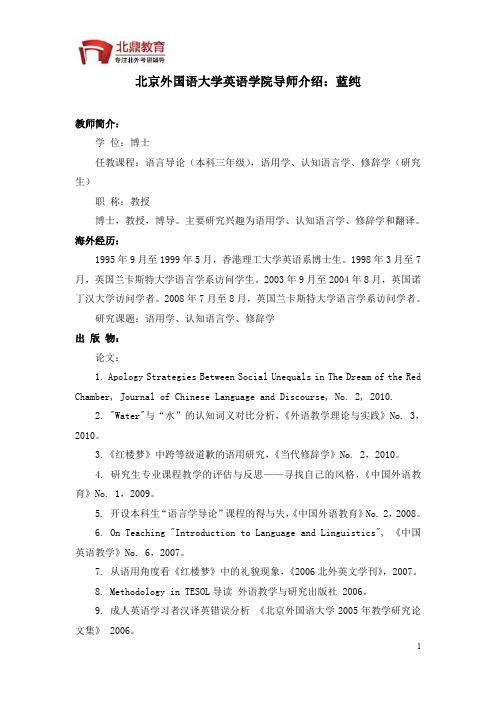
北外英语语言学及应用语言学
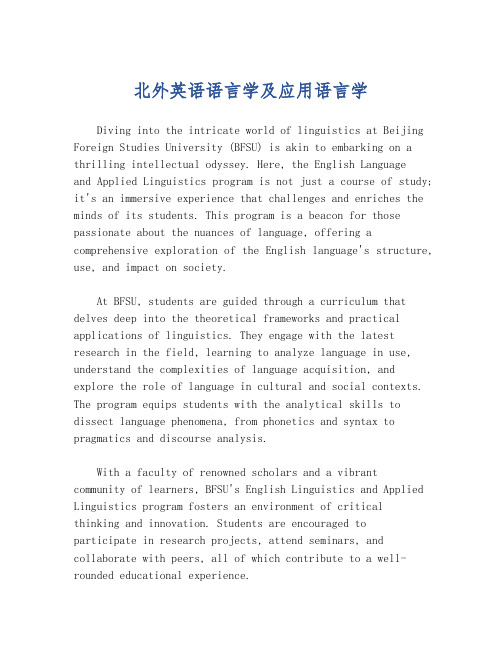
北外英语语言学及应用语言学Diving into the intricate world of linguistics at Beijing Foreign Studies University (BFSU) is akin to embarking on a thrilling intellectual odyssey. Here, the English Languageand Applied Linguistics program is not just a course of study; it's an immersive experience that challenges and enriches the minds of its students. This program is a beacon for those passionate about the nuances of language, offering a comprehensive exploration of the English language's structure, use, and impact on society.At BFSU, students are guided through a curriculum that delves deep into the theoretical frameworks and practical applications of linguistics. They engage with the latest research in the field, learning to analyze language in use, understand the complexities of language acquisition, and explore the role of language in cultural and social contexts. The program equips students with the analytical skills to dissect language phenomena, from phonetics and syntax to pragmatics and discourse analysis.With a faculty of renowned scholars and a vibrant community of learners, BFSU's English Linguistics and Applied Linguistics program fosters an environment of criticalthinking and innovation. Students are encouraged toparticipate in research projects, attend seminars, and collaborate with peers, all of which contribute to a well-rounded educational experience.Moreover, the program's practical orientation means that students are not only theoreticians but also practitioners. They are trained to apply linguistic knowledge in real-world settings, such as education, translation, and international communication. This dual focus on theory and practice prepares graduates for a diverse range of careers where their linguistic expertise is highly valued.In essence, the English Language and Applied Linguistics program at BFSU is a dynamic and transformative journey for those eager to unravel the mysteries of language and harness its power in the ever-globalizing world. It's a stepping stone for future linguists, educators, and communication specialists, setting the stage for impactful contributions to the field of linguistics and beyond.。
对外经济贸易大学2006年语言学考研真题

对外经济贸易大学2006年语言学考研真题考试科目:专业英语Section OneMultiple Choice Questions(15points)(1)Virtually every sentence that a person utters or understands is a brand-new combination of words, appearing for the first time in the history of the universe. Therefore, a language cannot be a repertoire of responses; the brain must contain a recipe or program that can build an unlimited set of sentences out of a finite list of words. That program may be called a _______grammar. It should be not confused with ____or____ grammars that are just guides to the etiquette of written prose.a) Proscriptive-teaching-mentalb) Mental-prescriptive-descriptivec) Teaching- descriptive-mentald) Mental-teaching- descriptive(2)The consonant [ s] in the word ―smile‖ can be described as :a) voiceless oral alveolar fricativeb) voiceless nasal bilabial liquidc) voiced oral alveolar plosived) voiced oral bilabial fricative(3)Which of the following is not a minimal pair?a) [li:f] [fi:l] b) [sip] [zip]c) [sai] [sei] d) [leit] [feit](4)Which of the following words is formed by the process of blending?a) WTO b) Motel c)Bookshelf d) red-faced(5)Deter mine which of the following description is the symptom of Wernicke‘s aphasia?a) The patients are often referred to as agrammatic because of their particularproblems with syntax, especially, with damage to the frontal cortex.b)These patients produce ordinary fluent speech with good intonation andpronunciation, but with many word substitutions.c)These patients produce ungrammatical utterances omitting function wordslike ‗a‘ or ‗the‘ or ‗was‘ and parts of words like the past tense suffix –ed.d) They are characterized by word-finding difficulties and disturbed word order. (6)The statement that supports the argument that human brain is structured in a form of module is________-a) Mental grammar is unconscious.b) People do not have UG when they are born.c) Patients can have split-brains.d)The relationship between sound and meaning of a word is arbitrary.(7) The speech act theory was developed by____________.a)John Searle b)John Austin c) Levinson d) G. Leech(8) In Krashen's monitor theory, "i" in "i + 1" hypothesis of second language acquisition refers to__________.a) interaction b) interference c) input d) intake(9) Wave model is a way created to represent___________.a) sense relations b) semantic fieldc) syntagmatic relations d) language families(10) Which of the following does not belong to the computational linguistics?a) machine translation b) corpus linguisticsc) speech recognition d) empirical study(11) Synonyms in English can be divided into three different categoriesa) noun synonym, verb synonym, adjective synonymb) dialectal synonym, stylistic synonym, relational synonymc)dialectal synonym, complementary synonym, collocational synonymd) dialectal synonym, stylistic synonym, collocational synonym(12) The statement "have never seen the man before" indicates ____________of the illocutionary point.a) directives b) expressives c) representatives d) commissives(13) Which of the following is NOT one of the four maxims of the Cooperative Principle?a) the maxim of quantity b) the maxim of qualityc) the maxim of manner d) the maxim of strength(14) V ocabulary change in language can include all excepta) addition of new words b) simplification of word formsc) loss of words d) changes of word meaning(15) According to the theory of conversational implicature, in the conversation "A: Shall we get something for the kids? B:Yes. But I veto I-C-E-C-R-E-A-M, ‗B‘s implicature is____________.a) I don't want the kids to know we are talking about getting them some ice-cream.b) I want to tell the kids how to spell the word before they eat it.c) I agree to get something for the kids, but not the ice-cream.d) I want to emphasize that what the kids will get is ice-cream, not hamberger. Section TwoDetermine whether the following statements are true or false and mark each witha "T" or "F".(10point.)1) English consonants can be classified two categories: voiced and voicelessconsonants.2) Wherever humans exist, language exists.3) All human language utilize a finite set of discrete units to form an infinite set of possible sentences.4) The word of ― impossibility‖ contains four morphemes.5)Bilabial consonant is produced when the obstruction is partial and the air isforced through a narrow passage.6)The speech sounds we hear and produce during linguistic communications are allphonemes.7)There are primitive languages—Some languages are more complex and notequally capable of expressing any idea in the world.8)Phonology and grammar are infinite, tightly structured systems, the child does nothave to master them before puberty in order to be a native speaker of the language.9)loss of identity.10)WA stem is the base form of a word which cannot be further analyzed withouttotal hen varieties of language are classified in respect of their users, they are called registers.Section ThreeTry to explain in two different ways to show that you understand the ambiguity involved. (10 points)a)He looked over the chair.b)I dislike naughty boys and girls.c)They are flying planes.d)He saw a piece of wood.e)She found the drill boring.f)They are lying on the grass.g)They are amazed by those matches.h)The men decided on the train.i)Mary and Jack or Bill frightened the cat.j)They fed her dog biscuits.Section FourTry to improve and write the following sentences by eliminating the redundant words or phrases. (10 points)a)The candidate repeated the answer again.b)His solution was equally as good as hers.c)He expressed a number of clear expressions much to the audience‘s delight.d)The exam was very trying, and I kept trying to finish on time without making toomany errors.e)In many cases students profit from the research paper.f)Her gossip was of a sordid and ugly character.g)In spite of the fact that she is lazy, I like her.h)Speed is also an important factor.i)He glanced at her in a suspicious manner.j) She seldom talks on any subject of controversial nature.Section FiveAnswer the following questions. (35 points)1.Give three examples to show the distinctive function of juncture in English. (5points)2.What are the differences between morphs and allomorphs? Please illustrate withone or two examples. (5 points)3.Try to analysis the following words by IC analysis. (3 points)Undesirable Gentlemanly Replacements4.Think carefully about the following two sentences, A and B. Then answer thequestions that follow. (7 points)A.His crime was killing someone. (He killed someone, and that was a crime.)B.His crime was killing someone. (The crime itself actually killed someone.)a)The main verb is BE in sentenceb)The main verb is transitive in sentencec)―What was his crime?‖ is a question ofd)―What was his crime killing?‖ is a question ofe)―What was his crime doing?‖ is a question off)―His crime wasn‘t killing someone‖ is a negative ofg)The word crime can be replaced by concrete animate nouns likebrother only in5.How many types of style deviations did G. Leech mention in his study of stylistics?Please choose to explain at least five types of them with examples. (5 points)6.In what way are sentence meaning and utterance meaning differ from each other?Give one example to illustrate your points. (5 points)7.Try to understand the following two paragraphs, and describe and comment whattwo contrasting approaches or perspectives of language studies each of the quotes represent. (5 points)a) A human language is a system of remarkable complexity. To come to know ahuman language would be an extraordinary intellectual achievement for a creature not specifically designed to accomplish this task. A normal child acquires this knowledge on relatively slight exposure and without specific training. Thus language is a mirror of mind in a deep and significant sense. It is a product of human intelligence, created anew in each individual by operations that lie far beyond the reach of will or consciousness. ( Chomsky )b)It is fairly obvious that language is used to serve a variety of different needs, butuntil we examine its grammar there is no clear reason for classifying its uses in any particular way. This enables use to give an account of the different functions of language that is relevant to the general understanding of linguistic structure than to any particular psychological or sociological investigation. ( Halliday ).参考答案Section One(1) d (2) a (3) a (4) b (5) a (6) c (7) b (8) c (9) d (10) d(11) d (12) d (13) d (14) d (15) aSection Two(1) T(2) F(At the primitive period of human beings, there wasn't language.)(3) T(4) F("im-" "possibl-" "-ity")(5) F(Bilabial consonant is made with two lips,and the consonant that is producedwhen the obstruction is partial and the air is forced through a narrow passageis called Fricative. )(6) F(Those are phones.)(7) F(There should be no classification of primitive language and civilized language.)(8) F(9) T(10) F(Registers are varieties of language classified according to the using of Language; while dialects are classified in respect of users.)Section Threea) From the IC analysis, the sequence "looked over the tree" could be illustrated in this way:(looked(over(the tree))) ((looked over)(the tree))Semantically, the different interpretations of the word "over" contribute to the ambiguity of the sentence. It could mean "Above and across from one end or side to the other" and also "Completely through, from beginning to end".b) The IC analysis of the sequence "naughty boys and girls" could be illustrated like this:(naughty(boys and girls)) ((naughty boys)and girls)This makes the sentence interpreted differently as: "I dislike naughty boys and naughty girls "and "I dislike girls and naughty boys".In terms of semantics, the semantic feature of "and" results in the ambiguity of the sentence. It could combine individual words like "boys" and "girls", and also phrases like "naughty boys" and "naughty girls".c) According to Generative Grammar, the sentence can have two different deep structures.d) The verb "see" is semantically polysemous in that it could refer to "to perceive with eyes" and also "to understand". Similarly, the phrase "a piece of wood" could also be interpreted as the actual wood and the metaphorical meaning "a part of the whole thing". Thus, the sentence could be interpreted as "He saw with his eyes a piece of wood" as its literal meaning and "He understood only a small part of the whole" as the metaphorical meaning.e) The ambiguity results in the polysemous words ―drill‖ and ―bore‖ in the sentence. The word ―drill‖ could refer to an implement or a kind of training; and ―bore‖ means ―to make a hole with a drill‖ or ―to make weary by being dull‖. Therefore, the senten ce may probably mean ―She found that the drill was digging‖ and ―She found that the training was tedious‖.f) The polysemous characteristic of word ―lie‖ contributes to the ambiguity of the sentence. Generally speaking, this verb could refer to either ―to be or place oneself at rest in a flat, horizontal, or recumbent position‖ or ―to present false information with the intention of deceiving‖. Thus, the sentence could be interpreted as ―They are not telling the truth on the grass‖.g) The word ―match‖ could be interpreted in different ways: ―A pair, each one of which resembles or harmonizes with the other‖, or ―A game or context‖, or ―A narrow piece, usually of wood or cardboard, coated on one end with a compound that ignites when scratched against a rough o r chemically treated surface.‖ Therefore, the meaning if the sentence is correspondingly ambiguous.h) ―On the train‖ could be interpreted differently due to the nature of ―on‖. One is to interpret this phrase referring to location, and the other is to tak e it ―relating to the train, concerned with the train‖. Correspondingly, the sentence has two different meanings: ―The place he decided was on the train‖ and ―He made a decision about the train‖.i) The ambiguity results in different ways to treat the sequ ence ―Mary and Jack or Bill‖.To illustrated in IC analysis would be like this:(Mary and (Jack and Bill)) ((Mary and Jack) or Bill)In terms of semantics, the semantic feature of ―or‖ results in the ambiguity of the sentence.It could combin e individual words like ―Jack‖ and ―Bill‖, and also phrases like ―Mary and Jack‖ and ―Bill‖.j) The sentence could be interpreted differently in respect of the deep structure.The identicalness of the possessive adjective case and the objective case of the pronoun ―she‖ contributes to the ambiguity of the sentence. When ―her‖ is regarded as the objective case, it would be taken as the indirect object of the verb ―fed‖; when ―her‘ is seen as the possessive adjective case, it then would be take as the modif ier of the noun ―dog‖.Section Foura)The candidate repeated the answer.b)His solution was as good as hers.c)He made a number of clear expressions much to the audience‘s delight.d)The exam was very challenging, and I kept trying to finish on time withoutmaking too many errors.e)Many students profit from the research people.f)Her gossip was of a sordid character.g)In spite that she is lazy, I like her.h)Speed is also important.i)He glanced at her suspiciously.j)She seldom talks on any controversial subjects.Section Five1.English employs four kinds of juncture for differentiating words and phrases.There is close juncture for intra-syllabic segments, syllable juncture between syllable, rhythm juncture between words, and pause juncture. Different junctures reflect different levels in the prosodic structure hierarchy in continuous speech.For example, as to the word ―bird‖ [bə:d], the juncture between [b] and [ə:] makes them realized distinctly and so is the transition from [b] to [ə:]. And the diphthong [iə] reveals the intra-syllabic juncture of the wor d ―here‖[hiə]. Juncture words cause such differences in sound as that created by the pronunciation of blackbird (one word) and black bird (two words).2. A morph is the phonetic realization of a morpheme. In some sense it correspondsto a wordform. A morpheme is manifested as one or more morphs (surface forms) in different environments. These morphs are called allomorphs. Anallomorph is a morph that has a unique set of grammatical or lexical features. For example, /z/ in ―dogs, beds‖; /s/ in ―cats‖; /iz/ in ―garages‖ , all these three morphs are different representations of the same morpheme of plurality. Because they belong to the same morpheme, they are also called allomorphs.3.undesirable gentlemanly replacements4.a)A b) B c) A d) B e) B f) A g) B5.There are certain structural differences between poetic language and standardlanguage. These violations or de-automatizations or foregroundings or differences are called deviations. Leech has classified nine types of deviation.(1) Lexical deviation. Neologism refers to the invention of new words, but we call some new words nonce-formations if they are made up ―for the nonce‖, that is , for a single occasion only, rather than as serious attempts to augment the English word-stock for some new need. For example, in Hopkins‘ poem The Wretch of the Deutschland, ―The widow-making unchilding unfathering deeps.”(2)Grammatical deviation. An example of this type of deviation is illustrated in the repetition of generative construction. ―Our hearts‘ clarity‘s health‘s fire, our thoughts‘chivalry‘s throng‘s Lord.‖(Hopkins, The Wretch of the Deutschland)(3) Phonological deviation.(4) Graphological deviation.(5) Semantic deviation. It is reasonable to translate semantic deviation mentally into ―nonsense‖or ―absurdity‖, so long as we realize that ―sense‖is used in strictly liter-minded way. For example, ―The child is the father of the man‖(a line from Wordsworth.)(6) Dialectal deviation. Dialectism is the borrowing of features of regionally defined dialects. It is quite often used by storytellers and humorists. For example, in The Shepherd‘s Calendar, Spencer uses homely provincial words like ―heydeguys‖ (a type of dance), ―rontes‖ (young bullock), and so on..(7) Deviation of register.(8) Deviation of historical period.(9) The use of foreign language. The use of foreign language may suggest the speaker‘s high education or an attempt to catch fashion. It is often found in literature. For example, many Chinese people use some foreign languages while speaking in Chinese ―见面说hello,来是come,去是go‖.6. 参见北京师范大学2003年“英语语言学”题Ⅴ答案。
北外语言学概论2006(610)

– 声带是两片富有弹性的肌肉,前端连结甲状 软骨,后端连结杓状软骨。杓状软骨的开合 回转,使声带或紧或松,或开或闭。呼吸或 发噪音时,声带放松,声门大开,气流可以 自由出入;发乐音时,声带靠拢,声门关闭, 气流从声门的窄缝里挤出,颤动声带,产生 响亮的声音。
– 3.口腔、鼻腔和咽腔(共鸣器,调音区)
这一节主要是介绍语音的物理属性。
一、 语音四要素
• 音高 • 音重 (音强) • 音长 • 音质(音色、音品)
语音的物理属性
声音是物体振动所产生的以空气为媒介传 播的一种声波。发音体由于外力的压迫, 由静止状态发生颤动,推动周围的空气 并使空气形成疏密相间的波,这就叫声 波。
声音有乐音和噪音之分:周期性出现重 复波形的音波叫乐音,不是周期性出现 重复的音波叫噪音。
毕业
受用
旷课
语言学概论
第七讲 3月20日
第三节 发音
一、 发音器官 二、 两类音素:元音和辅音 三、 元音 四、 辅音
这一节主要介绍语音的生理属性,掌 握元音和辅音的区别及发音原理。
一、 发音器官
•肺 • 喉头和声带 • 口腔、鼻腔、咽腔
1.肺(动力区)
肺是呼吸气流的活动风箱,是呼吸器官的中 心,也是发音的动力站。由肺部活动产生的 气流通过支气管、气管到达喉头,作用于声 带、咽腔、口腔、鼻腔等发音器官,经过这 些发音器官的调节,就发出各种不同的声音。
• 汉语中的声调主要是由音高不同形成的。
2.音强
音强指声音的强弱,它取决于声波振幅的 大小,振幅小,声音弱;振幅大,声音 强。振幅大小又取决于发音时用力的大 小,用力大,呼出的气流对发音器官的 冲击就强,声波振幅就大,声音就强, 反之则弱。现代汉语中,轻重音的差别, 主要是音强不同。
北外语言学概论课件2006(1-5)

教材: 叶蜚声 徐通锵《语言学纲要》北京大学出版社 主要参考书目: 徐通锵 胡吉成主编《<语言学纲要>学习指导书 》 北京大学出版社 高名凯 石安石主编《语言学概论》 中华书局
导言
一、语言学的对象和任务 二、语言学的性质和作用 三、语言学的分类 四、语言研究简史
一、 语言学的对象和任务
• 语言是语言学的研究对象 • 以语言为研究对象的科学,研究探索语 言的本质、结构和发展规律。
• 具体语言学是只研究某种具体语言的规 律的科学。它的研究对象只涉及一种语 言,例如,汉语语言学、英语语言学。 汉语语言学和英语语言学通常研究汉语 和英语语言系统中的全部构成要素,这 种语言学也被称为整体语言学。与之相 对的是部门语言学。
• 如果以研究对象存在的时间为着眼点, 可以分出共时语言学和历时语言学。共 时语言学是只截取语言历史中的某一个 横断面,进行静态的研究,不涉及从一 个时代到另一个时代的演变问题,例如, 现代汉语,就只研究汉语在现阶段的相 对静止的状态。
1. 古代印度的传统语言学
• 印度是东方的一个文明古国,是婆罗门教和佛教的发 源地。大约在公元前一千五百年的时候,印度就有了 一种用古代梵文写成的典籍《吠陀》( Veda)。它是 婆罗门教最古的经典。“吠陀”即智慧的意思,为了 传播和阅读这部经典,很早就有人对其进行研究,但 都是比较零碎的。公元前四世纪,印度伟大的语法学 家波尼尼( pänini )把前人的研究材料加以总结,写 成了著名的《梵语语法》,又称《波尼尼经》。《波 尼尼经》是用诗歌的题材写成的,全书 3996条,分章 讲述各种语言现象。
• 社会语言学:社会语言学是二十世纪六 十年代兴起的一门边缘学科。作为语言 学、社会学、心理学、人类学、民族学 和社会心理学等的综合性研究学科,它 的研究对象是语言的社会本质和差异, 研究的重点是语言的差异和造成差异的 社会因素。
全国2006年1月高等教育自学考试语言学概论试题_1
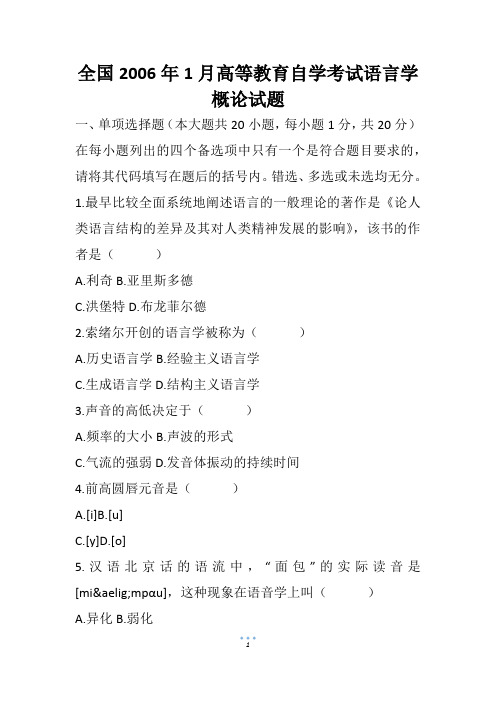
全国2006年1月高等教育自学考试语言学概论试题一、单项选择题(本大题共20小题,每小题1分,共20分)在每小题列出的四个备选项中只有一个是符合题目要求的,请将其代码填写在题后的括号内。
错选、多选或未选均无分。
1.最早比较全面系统地阐述语言的一般理论的著作是《论人类语言结构的差异及其对人类精神发展的影响》,该书的作者是()A.利奇B.亚里斯多德C.洪堡特D.布龙菲尔德2.索绪尔开创的语言学被称为()A.历史语言学B.经验主义语言学C.生成语言学D.结构主义语言学3.声音的高低决定于()A.频率的大小B.声波的形式C.气流的强弱D.发音体振动的持续时间4.前高圆唇元音是()A.[i]B.[u]C.[y]D.[o]5.汉语北京话的语流中,“面包”的实际读音是[miæmpαu],这种现象在语音学上叫()A.异化B.弱化C.同化D.强化6.“纸包不住火”、“三天打鱼,两天晒网”都属于()A.惯用语B.谚语C.成语D.歇后语7.英语单词worker中的-er是()A.词根B.词缀C.词尾D.词干8.学外语的人的母语叫做()A.来源语B.原始基础语C.目标语D.亲属语9.中国人看见红色往往会觉得喜庆,这种心理活动属于()A.直观思维B.逻辑思维C.发散思维D.表象思维10.认为不同的语言就有不同的思维方式的观点被称作()A.思维决定论B.语言相关论C.语言天赋论D.思维相关论11.患者基本上不能说话,但仍能听懂别人说的话,这种语言障碍叫做()A.皮亚杰失语症B.布洛卡失语症C.维尔尼克失语症D.斯金纳失语症12.提出人脑中存在“语言遗传机制”的学者是()A.萨丕尔B.沃尔夫C.乔姆斯基D.利奇13.儿童开始正确使用虚词和掌握形态变化时,就进入儿童语言获得过程中的()A.单词阶段B.双词阶段C.简单句阶段D.复杂句阶段14.如果人的右侧肌体瘫痪,这往往是由于人的大脑的某个部位受到损伤,这个部位是()A.左半球的有关部位B.右半球的有关部位C.小脑D.脑桥15.最小的有意义的能独立使用的语言单位是()A.义素B.语素C.词D.音素16.下面各项中属于句子和词组的本质区别的是()A.句子更有意义B.句子更长C.句子能独立使用D.句子有一定的语气和语调17.在语音和意义上跟文字所代表的语言单位都没有联系的字符是()A.音符B.意符C.记号D.字母18.日文的假名是典型的()A.音位文字B.音节文字C.辅音文字D.词语文字19.方言之间的差别主要体现在()A.语音差别B.词汇差别C.语法差别D.语义差别20.英语、德语、丹麦语等语言都来自于()A.拉丁语B.日尔曼语C.古斯拉夫语D.印地语二、多项选择题(本大题共5小题,每小题2分,共10分) 在每小题列出的五个备选项中有二至五个是符合题目要求的,请将其代码填写在题后的括号内。
- 1、下载文档前请自行甄别文档内容的完整性,平台不提供额外的编辑、内容补充、找答案等附加服务。
- 2、"仅部分预览"的文档,不可在线预览部分如存在完整性等问题,可反馈申请退款(可完整预览的文档不适用该条件!)。
- 3、如文档侵犯您的权益,请联系客服反馈,我们会尽快为您处理(人工客服工作时间:9:00-18:30)。
第六讲 3月16日
第三章 语音
第一节 第二节 第三节 第四节 第五节 第六节 语音研究的诸方面 音响 发音 音位 音位的聚பைடு நூலகம் 音位的组合
[教学目的和要求] 认识语音的属性,掌握人类发音的基本 原理;认识元音和辅音的区别及其特点; 掌握音位及音位组合的规则,能划分音 位,能用国际音标标注普通话的语音。
元音和辅音的区别
参见教科书59页: 1.气流是否有阻。 2.发音器官是否保持均衡的紧张。 3.气流的强弱。 以上三点,第1点是最重要的。 此外,若从物理属性考察,元音是乐音, 辅音都带噪音成分,有的是纯粹的噪音。
三、 元音
元音的不同是共鸣器的形状不同造成的。 影响共鸣器形状无非是三个因素: 1.舌位的高低(开口度大小)。 2.舌位的前后。 3.嘴唇的圆展。
声音有乐音和噪音之分:周期性出现重 复波形的音波叫乐音,不是周期性出现 重复的音波叫噪音。 语音同其他声音一样,具有音高、音强、 音长、音色四种要素。
1.音高 音高就是声音的高低。它取决于发音体 在单位时间内颤动次数的多少(频率), 振动次数多,频率大,声音就高,振动 次数少,频率小,声音就低。
16 19 17
13 14 11
2
£ ¨20£ © º í ½ á ¡ £
20
18
二、 两类音素:元音和辅音
元音:也叫“母音”。音素的一类。发音时气流 自由呼出,不受任何阻碍;发音器官各部分肌 肉的紧张均衡;气流比辅音为弱。 辅音:也叫“子音”。音素的一类。发音时气流 在发音器官的某一部位受到一定阻碍,造成阻 碍部分的肌肉特别紧张,气流比元音强。
毕业
受用
旷课
语言学概论
第七讲 3月20日
第三节 发音
一、 二、 三、 四、 发音器官 两类音素:元音和辅音 元音 辅音
这一节主要介绍语音的生理属性,掌 握元音和辅音的区别及发音原理。
一、 发音器官
• 肺 • 喉头和声带 • 口腔、鼻腔、咽腔
1.肺(动力区) 肺是呼吸气流的活动风箱,是呼吸器官的中 心,也是发音的动力站。由肺部活动产生的 气流通过支气管、气管到达喉头,作用于声 带、咽腔、口腔、鼻腔等发音器官,经过这 些发音器官的调节,就发出各种不同的声音。
1. 要注意将国际音标与英文字母、汉语拼 音方案的字母区分开来。国际音标没有 大写小写、手写体印刷体的区别。一个 字母的不同形体就是不同的音标,代表 不同的音素。如: [a] [A] [ɑ] 就 表示三个不同的音素。 国际音标使用时通常要加上方括号[ ] 。
2. 要注意将形体相似的音标区别开来。 例如: [z] [] [] [] 3. 国际音标记录语音有宽式标音和严式标 音之分。 宽式标音又叫“音位标音”,如:[ka] 严式标音又叫“音素标音”,如:[kɑ]
四、 应该从哪些方面去研究语音
发音---传递---感知 生理---物理---心理 发音学--音响学--听觉语音学 三个环节,三个方面,三门学科,都属 于对语音的自然属性的研究。 语音还有社会属性。
语音的属性
• 语音的自然属性包括 物理属性 生理属性 • 语音的社会属性 主要是指同一个音素在不同的语言或方 言中具有不同的作用,在交际中执行不 同的功能。
二、 语音的最小单位
语音是语音学研究的对象,各门学 科为了研究自己的对象,往往需要把它 分成最小的单位,然后研究这些单位的 性质、相互间的关系以及组合的规则。 最小的语音单位是从成串的话语中 切分、归纳出来的。
• 一般人自然而然地感觉到的自己母语里 最小的语音单位是音节。 • 可是音节还不是语音的最小单位。 音节还可以切分为音素,音素才是语音 的最小单位。 • 音素是人类语言从音质角度划分出来的 最小的语音单位。
– 鼻腔也是共鸣器,是个固定的空腔。它同 口腔靠软腭、小舌隔开。软腭、小舌可以上 下活动。呼吸时,软腭、小舌悬在中间,口 腔、鼻腔两方面通路同时打开。说话时,有 时软腭、小舌上升,鼻腔通路关闭,气流在 口腔发生共鸣,成为口音,如:a、o、e。 软腭、小舌下垂,关闭口腔通路,气流在鼻 腔发生共鸣,发出鼻音。如:m、n、ng。
八个基本元音(也叫正则元音)
[i] [e] [ ε] [a] [u] [o] [ ] [ɑ ] 前高不圆唇 前半高不圆唇 前半低不圆唇 前低不圆唇 后高圆唇 后半高圆唇 后半低圆唇 后低不圆唇
元音舌位图是怎样构成的?
嘴唇不圆,把嘴张得最大,即开口度最大,舌头尽量往前伸,发出来的音 像“爱”(ai)里面的一个音,国际音标标为[a]。同样条件下把舌头尽量往 后缩,发出来的音像“昂”(ang)里面的前一个音,国际音标标为[α]。 嘴 唇不圆,把嘴合拢,既开口度最小,舌头尽量往前伸,发出来的音像“衣”, 国际音标标为[i]。如果把舌头尽量往后缩,嘴唇拢圆,发出来的音像“乌”, 国际音标标为[u]。 [a] [α] [u] [i] 把四个极点围成了一个四边形,叫做元音舌 位图。变更口腔的形状所能发出的绝大部分元音都在这个图的范围之内。如 图示: 不 圆 前 后 不央 圆 圆 不 唇 圆 唇 唇 y 圆 高 最高 唇 圆 唇 i 唇 i u 次高 I Y 半高 e
4.音质(音色、音品) 音质也叫音色、音品,是声音的特色, 声音的本质,取决于声音振动形式的异 同。音质是声音的个性。它是一个声音 区别于另一个声音的基本特征。
音质的不同可以从声音的产生和音响两方 面来分析。
从声音的产生方面分析,造成音质的不同 的因素有以下三点: 1.发音体不同。 2.发音方法不同。 3.共鸣器的形状不同。 至于音响方面的分析见下面专门一个问题。
• 第三,发音时共鸣器的形状不同。二胡 和京胡都是弦乐器,发出来的音质却不 一样,这主要是因为二者共鸣器的形状 不同所造成。 • 语音中音质的变化,主要由于发音器官 状况的不同和发音方法的变化造成的。
• 总之,任何声音都是音高、音强、音长、 音质的统一体,语音也不例外,也由这 四种要素构成。但是,各种语言中这四 种要素的重要性不同。任何语言都把音 质作为最重要的区别意义的要素。对现 代汉语来说,音高的作用最重要(表现 在声调上),音强的作用差一些(表现 在轻重音上),音长的作用最弱(表现 在轻声上)。
2.音强 音强指声音的强弱,它取决于声波振幅 的大小,振幅小,声音弱;振幅大,声 音强。振幅大小又取决于发音时用力的 大小,用力大,呼出的气流对发音器官 的冲击就强,声波振幅就大,声音就强, 反之则弱。现代汉语中,轻重音的差别, 主要是音强不同。
3.音长 音长就是声音的长短,它取决于发音 体振动的时间的久暂。在语音中,发音 体振动时间持续的久暂,取决于发音动 作延续时间的长短。延续时间长,发音 体振动的时间就长,声音就长,反之则 短。
• 从声音的产生方面分析,有三方面的原因造
成音质的不同: 第一,发音体不同。笛子和二胡同奏一 个曲调,但人们能分辨出哪是笛子的声 音,哪是二胡的声音,就是因为笛子、 二胡发音体各异,因此,二者的音质也 就不一样。
• 第二,使物体发音的方法不同。二胡和 琵琶同是弦乐器,但前者用弓拉,后者 用手弹,发出来的音质就不同。
– 发音的主要动力是呼出的气流,叫呼气音, 现代汉语中也有靠吸入的气流作动力来发音 的。 – 如:啧、咝(声带不颤动)。
– 2. 喉头和声带(声源区) – 包括喉头和声带,喉头由四块软骨构成: 下面是一块环状软骨,上面是一块甲状软骨 和一对杓状软骨,四块软骨构成一个圆筒形 的筋肉小室。此外,甲状软骨上面还有一块 会厌软骨,可以上下开合。筋肉小室的中央 就是声带。
第二节 音响
一、 语音四要素 二、 音质的音响分析 三、 研究音响的仪器 这一节主要是介绍语音的物理属性。
一、 语音四要素
• 音高
• 音重 (音强)
• 音长 • 音质(音色、音品)
语音的物理属性 声音是物体振动所产生的以空气为媒介 传播的一种声波。发音体由于外力的压 迫,由静止状态发生颤动,推动周围的 空气并使空气形成疏密相间的波,这就 叫声波。
9
£ ¨11£ © Ñ Ê Ç » ¡ £ £ ¨12£ © É à ¼ â ¡ £ £ ¨13£ © É à Ò ¶ £ ¨14£ © É à Ã æ Ç °º Í É à Ã æ Ö Ð ¡ £
7 8 15
1
4
5 3 12
6
10
£ ¨15£ © É à Ã æ º ó » ò É à ¸ ú ¡ £ £ ¨16£ © » á Ñ á È í ¹ Ç ¡ £ £ ¨17£ © Ê ³ µ À ¡ £ £ ¨18£ © Æ ø ¹ Ü ¡ £ £ ¨19£ © É ù ´ ø ¡ £
– 声带是两片富有弹性的肌肉,前端连结甲 状软骨,后端连结杓状软骨。杓状软骨的开 合回转,使声带或紧或松,或开或闭。呼吸 或发噪音时,声带放松,声门大开,气流可 以自由出入;发乐音时,声带靠拢,声门关 闭,气流从声门的窄缝里挤出,颤动声带, 产生响亮的声音。
– 3.口腔、鼻腔和咽腔(共鸣器,调音区) – 口腔是主要的共鸣器,分上部、下部两 个部分。上部包括上唇、上齿、上齿龈、硬 腭、软腭和小舌,下部包括下唇、下齿和舌 头(分舌尖、舌面和舌根)。其中唇、舌、 软腭、小舌是能活动的器官,舌的活动性最 大;其他器官不能活动。口腔的后面是咽腔。 咽头是“三岔口”,下通喉头,前通口腔, 上通鼻腔,在发音时也能起共鸣作用。
国际音标的优点
1. 精确 音素和符号一一对应,很科学,不含混; 2. 方便 多数符号采用世界通用的拉丁字母的小写印 刷体,形体简单清晰,便于记忆,便于学习 和运用; 3. 完备 符号所代表的音和标音方法在世界各国基本 上是统一的,能精确地记录世界各国语言和 方言的语音。
学习和使用国际音标应注意的问题
三、 音标
• 为了把语音准确地记录下来,便于分析 和研究,需要有一套标记语音的符号。 • 记录音素的标写符号叫做音标。 • 目前世界上最通行的标音符号是国际音 标。
